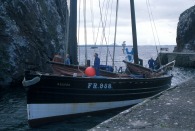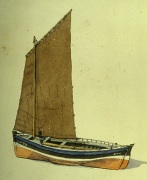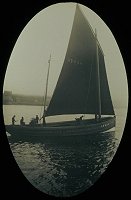Herring Home | Fishing for herring | Back to Early Scottish Fishing Boats
Scottish Sail powered fishing boats
Skaffie

Skaffies (sometimes spelled scaffie) were small clinker-built boats. They had a curved stem (bow) and steeply sloped stern (back). They were rigged boats with a tall dipping lugsail. In good weather they were easy to manoeuvre but in bad weather they tended to be unsteady. Their short keel meant that they could turn easily, so could enter small harbours. Skaffies were used on the south coast of the Moray Firth from the beginning of the 19th century or earlier. They had a crew of five.
The early skaffies were small and undecked and were light enough to be dragged up on to the beach. Conditions in these boats were very basic, with no shelter. They stayed within a few miles of shore, keeping the coastline in site. The skaffies were popular with the fishermen because they were quite cheap to buy and held lots of herring. By the 1880s these boats were at least part-decked and could be 42 feet (12.5 m) long with a hold and a forecastle that could hold eight bunks. Few were built after 1900.
Fifie

The fifie was another wind-powered sailing boat. It was the favoured boat on most of the Scottish East Coast and was used from the 1850s until well into the 20th century. These boats varied in design, but all had a vertical stem (front) and stern (back) and the wide beam (width) made them stable in the water. This design meant that they could carry very large sails. However, the long keel made them awkward to handle in confined spaces.
Fifies had two masts, a main dipping lugsail and a mizzen sail. To find out more, link to ‘the lugsail‘. The massive masts were placed far forward and aft so that there was a clear working space amidships. From the 1870s the larger fifies began to be carvel-built, which meant that they were built with the planking placed edge to edge instead of overlapping. Following the Washington Report (link), these boats began to be decked. A large fifie could be 70 feet (21.3m) in length. They were very fast sailing boats.
Baldie

In 1860 the baldie was introduced in response to the Washington Report. It was a smaller version of the fifie designed for inshore fishing, and was either half decked or fully decked. These boats were named after the Italian patriot, Giuseppe Garibaldi. The baldie was carvel, rather than clinker-built, meaning that the planks were edge-to-edge rather than overlapping. These boats were around 25 feet in length with a single dipping lugsail on a mast positioned well forward. They were light to row, although depended mainly on their lugsail. The advantage of the lugsail was that no bowsprit or bars projected beyond the hull, which meant these boats could be packed closer together in the busy herring fishing harbours.
Zulu

In 1879 a new boat called the zulu was produced. William Campbell of Lossiemouth designed the first of these in 1879, and it was called Nonesuch. It was a hybrid boat combining the best features of the fifie and skaffie. All but the earliest zulus were carvel-built because the edge to edge planking was stronger than the earlier clinker design. They had the upright stem (front) of the fifie and the raked stern (back) of the scaffie. The straight stem gripped the water well and allowed the boat to go faster with the wind, and the bow cut cleanly through the sea. The shape also gave a relatively long deck for the size of boat. This meant more space. The boat was named after the Zulu War, which was going on in South Africa at the time. The zulu quickly became popular and many were built in the following years.
The zulu had 2 masts - fore and mizzen, a bowsprit and a mizzen boom, set over the stern. Sails carried were fore, mizzen and jib. The sails on the zulus were very large and heavy, making them difficult to haul. Their masts could be 60 feet tall and had to be constructed from tall pine trees. They could be 2ft in diameter at deck level. The bowsprit could be fifty feet long, and even the mizzen boom was over thirty feet in length. The largest class of zulus were around 80 feet long. Towards the end of the 19th century steam capstans were introduced to help raise and lower the masts and sails, and to haul the nets. The zulu was eventually superseded by the steam drifter, although some were converted to steam and motor power.
Herring Home | Fishing for herring | Back to Early Scottish Fishing Boats